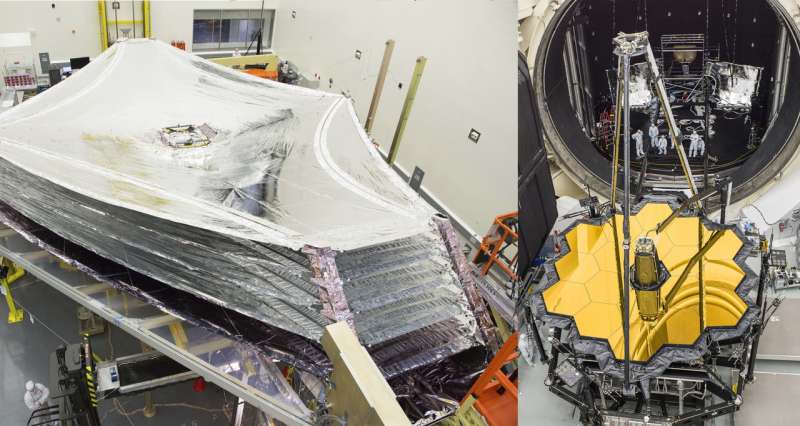Image: Webb Telescope's 'silver and gold decorations'

Webb telescope, or Webb, is NASA's upcoming infrared space observatory, which will launch in 2019. The two photos that compose this image highlight two important achievements Webb had in the latter part of 2017.
In early December, Webb's combined optical element and science instruments emerged from Chamber A at NASA's Johnson Space Center in Houston, where it successfully completed cryogenic testing. During testing, scientists and engineers at Johnson put Webb through a series of tests designed to ensure the telescope functioned as expected in an extremely cold, airless environment akin to that of space.
Webb's primary mirror consists of 18 beryllium mirror segments, and each segment is gilded with a tiny amount of gold—about a golf ball's worth for the entire mirror. Each mirror segment was gilded through a process called vacuum vapor deposition, where a miniscule amount of the precious metal is vaporized and deposited on each segment inside of a vacuum chamber.
In October, Webb's tennis court-sized, five-layer, deployable sunshield was fully tensioned at Northrop Grumman Aerospace Systems in Redondo Beach, California. During the tensioning process, engineers at Northrop carefully and deliberately stretched the sunshield to its fully deployed position. This was the first of several tensioning sessions the sunshield will undergo.
Though the sunshield appears silver, each layer is actually coated with reflective aluminum. The sunshield is composed of what are essentially sheets of special plastic that maintain their integrity at extreme temperatures. Each sunshield layer is only about 1/1000th of an inch thick.
These two halves of the James Webb Space Telescope observatory—Webb's combined science instruments and optics, and its combined spacecraft bus and sunshield (called the spacecraft element)—will be integrated at Northrop Grumman in 2018. Webb will launch from Kourou, French Guiana in 2019.
Webb's eventful year
These most recent accomplishments were among several Webb had for 2017. In March, the telescope's combined optics and science instruments completed acoustic and vibration testing at NASA's Goddard Space Flight Center in Greenbelt, Maryland, before moving to Johnson for cryogenic testing.
"This was a pivotal year for Webb. With launch environment and cryogenic testing completed, we have demonstrated our science payload functions as planned," said Eric Smith, program director for Webb telescope at NASA. "In 2018, the telescope will meet up with the other iconic and now completed component of Webb, its sunshield and spacecraft, to form the observatory."
On the scientific front, September saw worldwide participation from the science community for the Director's Discretionary Early Release Science (DD-ERS) program, and in November, NASA announced the proposals it selected for the DD-ERS program. The science observations for these proposals will be completed within the first five months of Webb's science observations.
"Though there is still observatory testing ahead of us, the response this year from the science community for Early Release Science shows that there are exciting questions already queued up for Webb to answer," Smith said.
The James Webb Space Telescope is the world's premier infrared space observatory of the next decade. A barrier-breaking mission for engineers and astronomers, Webb will solve mysteries of our solar system, look beyond to distant worlds around other stars, and probe the mysterious structures and origins of our universe and our place in it. Webb is an international program led by NASA with its partners, the European Space Agency (ESA), and the Canadian Space Agency (CSA).
Provided by NASA





















